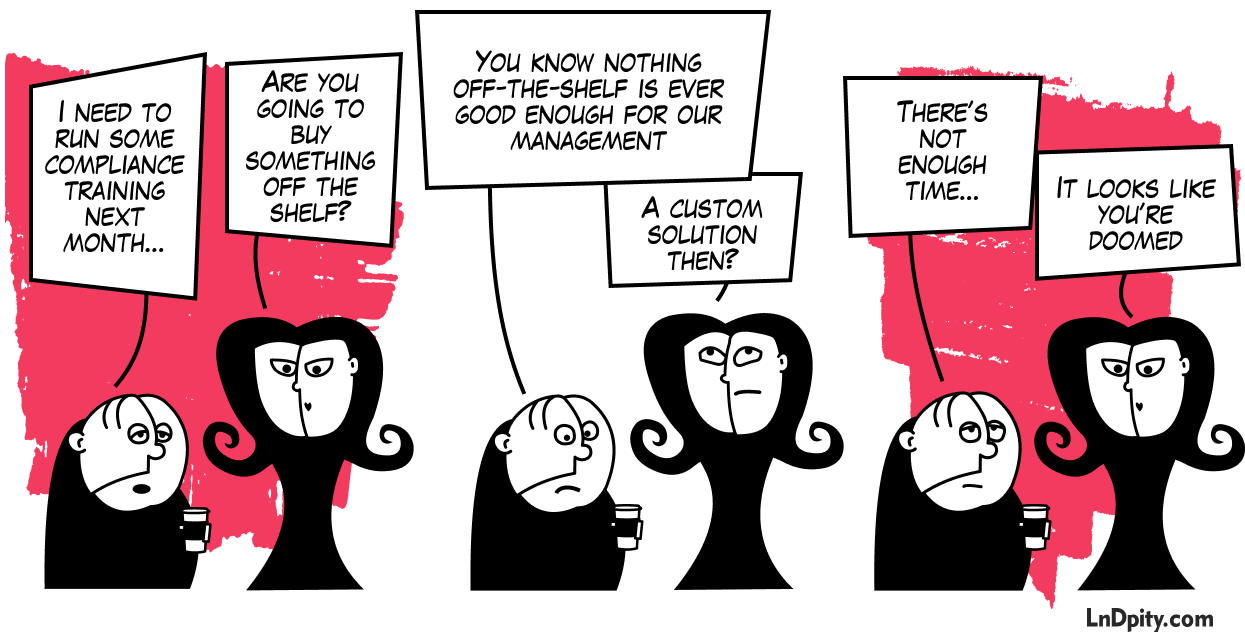
Legal and regulatory requirements apply to all organisations. No matter what industry they operate in, organisations are governed by regulatory authorities. To meet these requirements, organisations have to ensure that their employees understand the legal framework that applies to their role.
These laws and regulations are not company specific. They apply to all companies throughout their industry or country of operation. Therefore, training employees on these topics will be relatively similar for all companies that need to comply with the same guidelines.
It seems reasonable to first look for generic content when it comes to planning on compliance-based subjects. As there is so much pre-built content available, the thought of developing compliance training from scratch can often seem like reinventing the wheel.
What is off-the-shelf learning content?
Off-the-shelf content is a pre-built, generic learning content on a particular subject. Typically, off-the-shelf content covers general topics, such as industry or country regulations that affects many businesses in the same way.
The content has been developed by e-learning experts and consultants with experience in this area and can be used out-of-the-box.
What is bespoke learning content?
Bespoke learning content is exactly what it sounds like. It is custom-built learning content that is tailor-made to fit an organisation’s needs. Often, this type of content will have company-specific language, examples and content.
This content can be developed internally, or built in collaboration with external vendors or subject matter experts (SMEs).
How to decide between off-the-shelf and bespoke compliance training
As with any business; you’ll have specific needs, constraints and objects that will impact your preference. Both types of content have their benefits, and both have their drawbacks.
We’ve weighed up the pros and cons of off-the-shelf compliance training content and bespoke e-learning, and how they fare against typical resource restraints.

Urgency
Off-the-Shelf is great if you need something immediately.
The content has already been well thought-through, is fully developed and will have been properly tested. In most cases, it should be ready to load into your Learning Management System (LMS) and distributed throughout your organisation.
Bespoke is a better choice if you have time for a training needs analysis, collaboration with SMEs, developing the required content including multimedia, testing and Q/A, piloting the training… If you’re thinking about creating bespoke learning content we recommend reading our article about getting started with digital workplace learning content.
Budget
If you only have a small number of employees that need to be trained, you might opt for prepackaged solutions. These will usually have the cost of development already in their pricing as it is split over all of the buys of the solution, and there are little overhead costs involved.
Off-the-shelf is typically going to be the cheaper product in the short term. As it is already developed, there are no production or development costs. The two most common charges are the amount of people who will be using the training (and this is often capped at a maximum price), and the set-up fee.
However, training may be issued on a lease basis with off-the-shelf. The most common situation is that after 36 months, you’ll pay to have the lease renewed. Therefore if you’re thinking about budgets in the long-term – for training you’ll be issuing regularly – bespoke will eventually work out cheaper.
Know-how availability
Off-the-shelf is a good route if most of the know-how needed can’t be sourced internally. With prepackaged solutions, the SME has already been sourced and your personal input isn’t needed. The content is created by professional learning developers and often packed with interactive multimedia.
Bespoke could be a better choice if you have at least some of the key players of content development in-house, such as SMEs, instructional designers, graphic designers etc. For smoothless content development you will also need to put in place a sort of an authoring collaboration process.
Likewise, if you find a vendor you trust and your budget allows it, you can outsource the project to them entirely and still go for a bespoke solution. In both cases, you also need to consider the availability of key stakeholders as a lot of their time and effort will be required in creating, coordinating and signing the content.
Topic
If the topic is one that is not specific to your organisation, there are plenty of off-the-shelf e-learning solutions that are ready for distribution. These are topics like Data Protection, Information Security, Fair Competition etc.
If you need to cover a highly specific topic, it’s hard to find off-the-shelf content that will cover this, bespoke is the way to go. This may be compliance procedures that relate to your internal systems, or processes that are unique to your organisation.
Risk assessment
Off-the-shelf might be the best choice if the compliance e-learning is done to satisfy regulatory requirements, but the area covered doesn’t present a high risk to the organisation.
Bespoke e-learning could be right for you if the area covered by the training presents a high risk to your organisation. If this is the case, you must ensure that every aspect is covered in a way that is relevant to your organisation’s specific situation (e.g. GDPR course for employees of companies that track user location data).
Training objectives
If your organisation’s compliance is the main goal, then off-the-shelf is the quickest solution. Pre-built e-learning courses have been approved by SMEs to ensure that the content is aligned with industry best practice and compliance standards.
If, however, you want to use compliance training as an opportunity to engage with your employees and share organisational values, bespoke is a better fit.
This is because bespoke content allows you to add relevant elements that your employees can relate to and use the tone of voice and branding specific to your organisation. Ultimately, these factors make the learner connect better with the content.
Content longevity
Off-the-shelf is a better solution if no significant updates on the subject are expected. Subjects like GDPR or Conflicts of Interest will usually stay relevant for long periods of time, and can remain relevant for years to come.
Similarly, you may need to deliver training on subjects that relate to a specific time period and won’t be used again, so it might not be worth going into custom content development. This approach can be useful on subjects like COVID-19, where we can hope that the training will not be used again once the pandemic is over.
However, it may be the case that even legislation changes from time-to-time. If you don’t have the resources to update the content yourself, you need to check whether the vendor will apply these updates themselves. It is essential that before buying off-the-shelf compliance training, you establish if the vendor will update the content as and when the legislation changes.
In a situation where a particular subject requires on-going training, but also regular updates, these needs can only be met with bespoke training. Bespoke content gives you full ownership, so you will be easily able to make any updates or revisions as your organisational needs change.
You should also keep in mind that not all bespoke content (such as videos) can be easily updated. Likewise, having a full ownership of the content means you are also the one responsible for content being up-to-date with the latest regulatory changes.
Other things to consider
There are four other key points to consider before investing in any content. The first is the learning experience. Before buying an off-the-shelf solution you should test it in your existing LMS (if you have one) to make sure everything works smoothly and the way you’d want.
Secondly, you should analyse any special training requirements you have. Do you require offline availability? Will people access the training on their personal devices? How does it work in case of company shared devices? How about employees who don’t have email addresses – how will they register and log in? These are all elements that should be considered and tested before you reach the buying stage of the off-the-shelf solution.
Thirdly, is the content accessible to everyone in your organisation? You may well have employees with reading disabilities or visual impairments, and not all off-the-shelf compliance training can meet the needs of these individuals. Make sure you choose a vendor who can cater to these needs as compliance training is mandatory.
Finally, do you have an LMS available? If not, then it’s likely that an off-the-shelf solution that comes with its own platform is the way to go. In that case you need to be sure it satisfies your organisation’s internal standards, such as GDPR and InfoSec, as well as your own reporting needs. Here you can read more on how to select the right LMS for your compliance training.

What about a middle ground?
After comparing the two, you might find that neither solution is exactly right. Off-the-shelf might not meet your specific business needs, but creating bespoke content from scratch perhaps exceeds your budget.
Customising off-the-shelf content means you can mix and match aspects of both approaches to create a compliance training solution that works best for your needs.
The levels of customisation can differ from vendor to vendor, but they typical allow you to:
- Apply your own branding
- Add your additional resources (e.g. documents, videos etc.)
- Mix and match pre-built content pieces
- Adapt the content, such as adding your company practices, regulations, examples and removing irrelevant bits
Some customisable content can be edited in-house, but other providers will make the changes for you.
Before deciding which solution is right for you, it is important to consider the following:
- To what extent can the content be customised?
- How difficult is it to customise the content?
- What tools do you need to edit the content?
- Do you have the know-how to use these tools internally?
The Bottom line
No matter which approach you take, bespoke solutions will always meet your needs better than off-the-shelf. However, as we have seen, bespoke solutions require time, budget and resources that aren’t always available.
If it does exist, you’re not taking the ‘easy path’ in using it. It’s there for a reason. Time and budget are precious entities for any business. What is important, however, is to make content as personal as possible where you can. Compliance training can be heavy, so making something that the learner will engage with can make the world of difference.
And last but not least, give your content one final check before launching the training.




